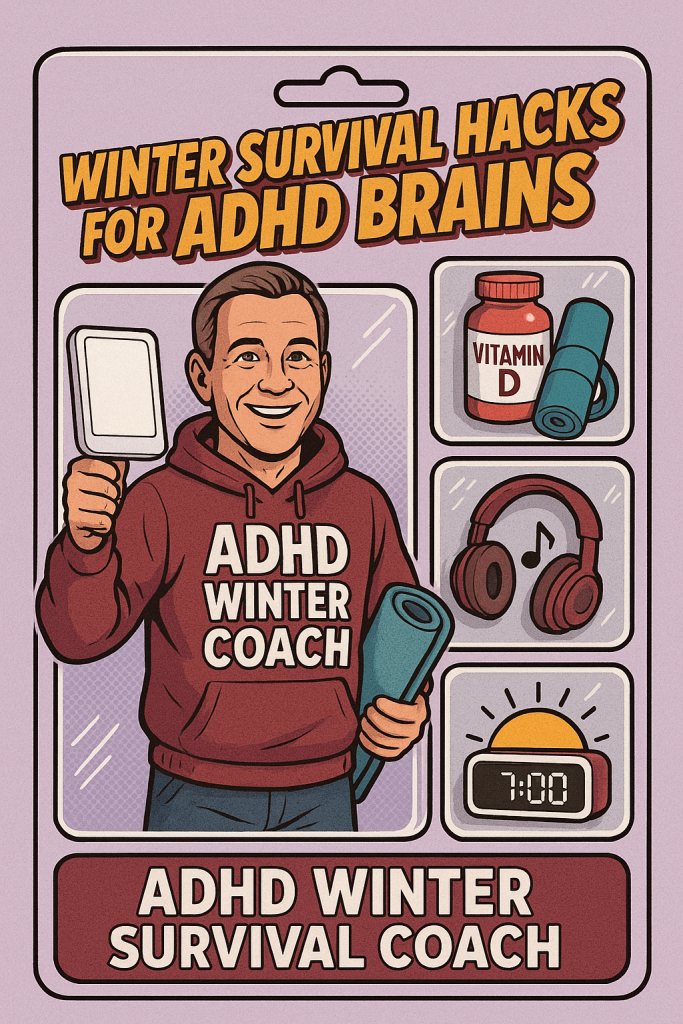Why Autumn and Winter Make ADHD Feel Heavier and What You Can Do About It
The other morning I woke up, pulled the curtains open, and… nothing. Just grey. No sunrise, no golden glow, just that flat autumn light that makes you wonder if your alarm clock has gone rogue. By the time I’ve made a cup of tea, I’m already missing those summer mornings when I could roll out the yoga mat in the garden and pretend I was a very stiff version of Mr Miyagi.
If you’ve noticed that sluggish feeling creeping in since summer packed its bags, you’re not imagining it. For adults with ADHD, the shift into autumn and winter can feel like somebody has quietly removed all the batteries from our brains. Let’s dig into why that happens, and then I’ll share some practical ways to put the energy (and light) back.
Why ADHD + Winter = Extra Sluggishness
Less light = lower dopamine and serotonin. ADHD brains already run low on these “feel good” chemicals. Reduced daylight makes the dip sharper.
Circadian rhythm chaos. Many people with ADHD have naturally delayed sleep patterns. When the mornings are darker, it’s even harder to wake up and feel alert.
Seasonal Affective Disorder (SAD). Research shows adults with ADHD are more vulnerable to SAD, which means that winter blues hit harder than for neurotypical brains.
Exercise habits disrupted. If your favourite yoga spot or walking routine depends on daylight, suddenly you’re stuck inside staring at a wall instead of the horizon.
A Winter Survival Guide for ADHD Brains
Think of winter like an obstacle course. You don’t need to “power through” it, you just need a few clever hacks.
🌞 Light & Energy
Light therapy lamp. A 10,000 lux lamp for 20 minutes in the morning helps reset your body clock.
Morning sunlight habit. Even 5 minutes outside before 10am helps tell your brain it’s awake time.
Vitamin D. In the UK, many adults take a supplement over winter (check with your GP).
🏃 Movement Indoors
Yoga inside. Roll out the mat in the living room ambience matters less than consistency. Stress often builds up as muscle tightness, particularly for ADHD adults who experience overwhelm. Yoga has the added benefit of stretching your muscles so you start the day more relaxed.
5-minute routine. Mix stretches, a few squats, and even a dance break to a favourite track. Short bursts are better than nothing.
Visible cues. Keep your mat or resistance bands where you can see them. Out of sight = out of mind.
Soundtrack for focus. Many ADHD brains like a bit of background stimulation. Try pairing exercise or chores with a favourite playlist, audiobook, or podcast. It keeps your mind engaged while your body moves.
🧠 Mood & Motivation
Novelty. Rotate playlists, try a new recipe, or walk a different route. Small changes spark dopamine.
Accountability buddy. Winter isolation makes depression worse. Even a weekly check-in call helps.
Reward system. Pair boring tasks with little treats “finish 20 minutes of emails, then coffee + YouTube clip.”
🛏 Sleep & Structure
Consistent wake-up. Anchor your day even if bedtime drifts.
Sunrise alarm clock. A gentle fake dawn can make mornings less brutal.
Evening wind-down. Try swapping late-night screens for a podcast, music, or even a proper wind-down stretch.
Quick 5-Minute Indoor Reset Routine
When it’s grey and grim outside, here’s a simple reset you can do without leaving the house:
- Stretch tall, breathe (1 min) reach overhead, fill the lungs. Stress often shows up as muscle tightness, especially when you’re overwhelmed. Stretching helps loosen that grip.
- Squats or chair stands (1 min) get the blood moving.
- Cat–cow stretch (1 min) on all fours, arch and release your spine.
- Dance or star jumps (1 min) instant dopamine.
- Forward fold (1 min) – hang loose, sway gently, reset.
- Set your intention (1 min) before you move on, pause and ask yourself: “What do I want to focus on today?” A simple cue like this can anchor your ADHD brain and reduce that scattered feeling.
Final Thought
If summer felt easier, it’s because nature was giving you free dopamine in the form of light, warmth, and long days. In winter, you just need to create those supports artificially: light, movement, novelty, connection. It’s not about willpower, it’s about clever design.
I work with adults who feel exactly this way every autumn, stuck, under-energised, and a bit cross with themselves for not being more productive. Coaching helps to put structures in place that match how your ADHD brain actually works, so you’re not fighting the season alone.
👉 If this resonates, click here to book a discovery call with me. We’ll talk about how to make winter feel lighter and set you up for a stronger year ahead.
See here for 5 ADHD Imposter Syndrome: 7 Ways to Turn Self-Doubt into Strength
